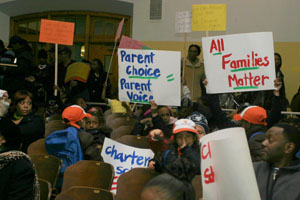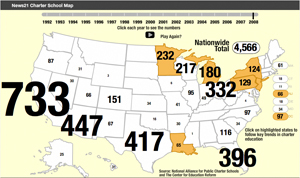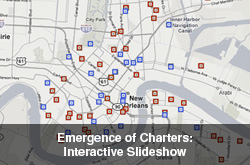The Business of Educating Harlem Students
Kyla Calvert | Jun 04, 2009 | Comments 5

Parents waiting in the long line to enter the Harlem Education Fair on Feb. 28. Kyla Calvert/COVERING EDUCATION
By KYLA CALVERT
Parents and children flocked to Harlem’s Education Fair on the City College of New York Campus in late February to try and decide which school among the new and unprecedented variety of neighborhood schools would be best for them.
Inside, 55 Harlem charter, parochial and traditional public schools were vying for their attention, many with full-color banners and professionally-printed brochures. The five traditional zoned public schools represented had a rough time getting noticed with only homemade displays to advertise their wares.
“”I agree with the philosophy that competition breeds excellence,” said Charles DeBerry, principal of P.S. 76, a school with about 370 students in kindergarten through sixth grade.
“But color copies are expensive. One of these costs me $.25,” DeBerry said, holding up a simple brochure created by some of his staff members. “I look at the things the charter schools are sending out and there’s just no way I can compete with them.”
Since 2003, Harlem has become a laboratory for the competition between traditional and charter schools that charter advocates believe will improve education for all children. Nineteen new charter schools have opened in the area in the last six years, bringing the total number of charters in Harlem to 22. Of all of the charter schools operating citywide this year – nearly 30 percent of them are squeezed between 100th and 145th Streets in Upper Manhattan. The growth of charter schools in the area is no coincidence. For decades the community’s schools have routinely been among city’s worst performing.
“In Harlem they always took out the special programs. There were no gifted and talented schools,” said Halana Richardson, who grew up in Harlem attending public schools in downtown Manhattan. Her mother, a Board of Education employee, was always diligent about filing the paperwork to transfer her to schools in better performing districts.
“Downtown we sat down and they instructed us,” she said. “In Harlem there are too many kids leaving school with no education, the principals just pushing them along.”
Richardson’s own two teenage children have attended both public and charter schools in Harlem and other neighborhoods in the city. Her daughter is currently enrolled at Harlem Day Charter School, but Richardson was at the Education Fair seeing what other schools are available.
While the rapid growth of the charter school community in the neighborhood has changed the educational landscape for Harlem students and their parents, some are adapting more quickly than others.
“We didn’t know about the fair last year and this year we only knew about it because our parents got flyers in the mail and brought them to school to show us,” said Zenja Murrell, a teacher and member of the School Leadership Team at P.S. 125.
She was frustrated about having to man a recruiting table instead of teaching in a classroom. “We are no longer in the business of educating students,” she said. “We are in the business of enrolling students.”
The business of enrolling students is a highly competitive one, and sometimes beyond the public schools’ budgets. Like anyone who attempts to do more with less, DeBerry was not easily stumped. He found a printer that can run 5,000 color postcards for $250.
“I can get $250,” he said, “Even if it comes out of my own pocket.”
DeBerry felt his school deserved a better shake. Last year, more than 41 percent of the students in P.S. 76 performed at or above grade level on the state’s English Language Assessment test and more than 64 percent did so on the math test. Moreover, two-thirds of his lowest performing students progressed by at least one grade level. This record earned his schools a “B” on the Department of Education’s annual school report cards.
DeBerry’s plan is to personally place the postcards in the mailboxes of every apartment in his zone. “That way at least they’ll know we’re here,” he said, “and that we have programs and services for their children.”
The importance of parents knowing their zoned schools are still in business may be more important in Harlem than in other neighborhoods where the concentration of charter schools is not as dense and the rhetoric not as heated. Teachers and administrators at zoned schools are convinced that battling to maintain student enrollment is about defending their existence.
“In essence, the presence of charter schools is downsizing zoned schools,” said Murrell of P.S. 125. “And, we’re told we have to increase our enrollment or phase out.”
***

Parents and students crowed the P.S. 194 auditorium March 10. Kyla Calvert/COVERING EDUCATION
One harsh reality of schools competing in a market environment is that some schools have to lose. Ten days after the Harlem Education Fair, parents and children from P.S. 194 and Harlem Success Academy 2 charter packed the P.S. 194 auditorium for a public hearing about the Department of Education’s proposal to move the charter school into the space now occupied by P.S. 194 students. The Department of Education had decided P.S. 194 would be phased out due to its failing scores. Parents at the zoned school were fighting for their school to stay alive.
Since the hearing, the Department reversed its decision to close to the school following a lawsuit filed by city parents, the American Civil Liberties Union and the United Federation of Teachers, parents, teachers and administrators. The suit alleged that the city was violating state law by eliminating public schools without the input of community boards.
But that night, sections of the audience cheered when a Harlem Success Academy 2 parent testified that charter schools teachers were more dedicated than public school teachers. Equal numbers gave a standing ovation to the P.S. 194 guidance counselor who cited rising test scores at the school and argued the school’s new administration, installed at the beginning of this school year, had not been given an opportunity to prove itself.
“I didn’t come here to close a school, I came here to rebuild a school,” said P.S. 194 Principal Charyn Koppelson Cleary, who said that even though the school earned a “D” on the citywide progress reports last year, approximately 47 percent of her third and fifth grade classes performed at grade level or higher on the social studies tests they took this past winter. These tests are considered good indicators of how students will perform on the New York State English Language Assessment tests.
“They are burying us with old school data,” Koppelson Cleary said. “There are enough kids in Harlem that need a decent – no, an excellent education, that we can help Harlem Success Academy find a home and rebuild ours.”
The scene was not unique in Harlem. Another school, P.S. 241, was one of the schools slated for closing this fall that was given a reprieve April 2 in response to the parent lawsuit. In February, the Department of Education announced that Harlem Success Academy 4 would move into the building, leaving no regular zoned elementary schools for families in that area of District 3.
Parents choosing Harlem’s charter schools for their children see the new schools as places to give their children the kind of education that Halana Richardson and others like her often had to travel downtown to get in the past.
“In the past, in District 5 we could go downtown, to another borough or to private or parochial schools,” said Kevin Riley, who sends his son to Harlem Success Academy 2. “It’s time for people to stay in the community and use resources that are available in the community. Now, Harlem Success Academy is the best choice in District 5.”
Parents of P.S. 194 students argue their school would be a better option for the neighborhood’s children if it were properly supported by the Department of Education. In a letter to the chancellor that she read to the audience at P.S. 194, Ta-Tanisha Rice, a parent member of the school’s Leadership Team, argued the four inept principals prior to Koppelson Cleary had slowly dismantled the school. According to Rice’s letter, parent and teacher requests for site visits by Department of Education representatives to help turn the school around were not granted until those representatives showed up to announce the school’s closing.
According to Melody Meyer, a press secretary for the Department of Education, P.S. 241 and 194 were originally scheduled for closing because they were among the city’s lowest performing schools.
“Even given the level of poverty of students coming in, we have schools across the city serving similar populations and doing a better job,” Meyer said.
Despite assurances that closings are based on how well students are served, teachers and administrators worry that phase-outs may not be limited to schools like P.S. 194 and 241, whose students struggle on standardized tests.
Kindergarten enrollment at P.S. 76 is around 40 students this year; a dramatic drop from the 60 students DeBerry expects every fall. Only four of the students zoned for his school ended up attending charter schools instead, but he suspects that overflow from other traditional public schools that filled his classrooms in past years is down thanks in part to charter schools’ ability to advertise often and across unlimited geographical areas. Eight of the school’s 60 fourth graders from last year left for charters this past fall.
“I have opened my eyes to the things we need to do to stay in business and offer services to kids,” DeBerry said. “We have to advertise. If we do not recruit kids and allow our registration to dwindle it will be seen as parents not electing to send their kids here. That was a lesson learned after the events at P.S. 241 for me.”
Filed Under: New York City • Unchartered Territory
About the Author:














Jenny and I was like peas and carrots.
Thanks for your blog post. It has given me a little to think about. Thanks again!
After looking over this blog post I took a look around the site. You have done a great job gathering all this information.
Many thanks for discussing such an topical article with all of us. I’ve bookmarked your blog will come back for a re-read again. Keep up the great work.
I’ve got about $500 in startup capital, but was hoping that since I’ve in all probability only have one or two chances with $500 to do things correctly, you’d all point me in the right direction. Don’t get me wrong, that website is FULL of abundant information, but individual experience would be a fantastic addendum to the website info.